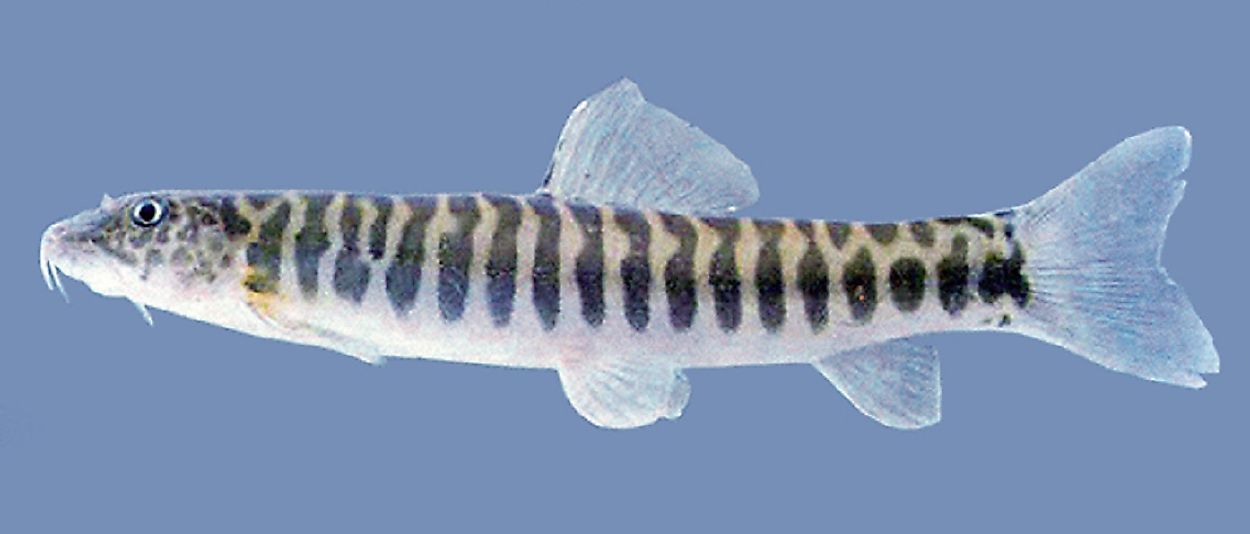Native Fish Of Ethiopia

Ethiopia’s rivers and lakes are filled with many endemic species of barbels, catfish, loaches, and other fish. Ethiopia is home to a rich diversity of freshwater fish species. The country has numerous water bodies, being suitably located in the Rift Valley. Abundant fish species are found in the major rivers of the Blue Nile and River Omo and the largest lake in the country, Lake Tana. There are 175 fish species that have been identified in the East African country, with 40 of them being found exclusively in Ethiopia. This fish species have fueled the growth of the aquaculture sector in the country.
Nile Catfish (Synodontis batensoda)
The Nile Catfish (Synodontis batensoda) inhabits the Blue Nile in Ethiopia. The fish is differentiated from other Synodontis species by 39 to 42 gill rakers instead of 7 to 33. The fish appears grey-black tinged with brown and numerous black spots. The Nile Catfish has contiguous adipose and dorsal fins. The fish mainly swims upside down and may reach a maximum length of 50 centimeters. The Nile Catfish is omnivorous feeding on crustaceans, mollusks, and insects as well as algae, plankton, and detritus. So far, the fish has been listed as Least Concern as no major threats to its sustainability have been identified.
Bayad (Bagrus bajad)
The Bayad (Bagrus bajad) inhabits the Blue Nile, Baro, and Tekeze basins in Ethiopia. The fish is elusive and feeds and lives near the bottom of the water bodies. Small fish, crustaceans, insects, mollusks, detritus and vegetable matter make up much of its diet. The fish appears yellow-greenish or blackish with a white belly. A smooth spine characterizes the dorsal fin, and the fish has four pairs of barbels. The Bayad may grow up to 112 centimeters and the female lives up to 8 years and seven years for the male. The fish is commonly captured and sold as food, and it is listed as Least Concern due to its wide habitat range and their existence in large numbers.
Ethiopian Straightfin Barb (Barbus pleurogramma)
The Ethiopian Straightfin Barb (Barbus pleurogramma) inhabits the Awash Basin and several rift lakes in Ethiopia. The fish prefers water bodies with high plant diversity. The Ethiopian Straightfin Barb spawns amidst vegetation in the months of January and February laying eggs in groups numbering 250 to 2,500. It feeds on algae and detritus and crustaceans, small insects, and snails. The fish is popular for human consumption. Although it has been listed as Least Concern, the fish is continuously threatened by illegal fishing methods and water pollution.
Tana Lake Stone Loach (Afronemacheilus abyssinicus)
The Tana Lake Stone Loach (Afronemacheilus abyssinicus) is endemic to Ethiopia. The fish is a species of the greater stone loach, and it inhabits the Blue Nile which flows from Lake Tana. Little information is known in regard to this small, slender fish, which grows to a maximum length of 4 centimeters. Its environmental status is unknown due to its narrow population range.
Conservation of Fish in Ethiopia
Other native fish species of Ethiopia include the Mustache Upside-Down Catfish, Ethiopian Barbel, Turkana Perch, Afrera Cichlid, Ethiopian Log Sucker, and Butterfish. Most of the water bodies in Ethiopia are under-utilized, and this has helped to conserve the native fish species. Emerging threats such as water pollution and illegal fishing practices are environmental concerns to the country’s rich aqua life.
Native Fish Of Ethiopia
| Native Fish of Ethiopia | Scientific Name |
|---|---|
| Tana Lake Stone Loach | Afronemacheilus abyssinicus |
| Mustache Upside-Down Catfish | Synodontis membranacea |
| Ethiopian Barbel | Barbus ethiopicus |
| Turkana Perch | Lates longispinis |
| Afrera Cichlid | Danakilia franchettii |
| Ethiopian Log Sucker | Garra aethiopica |
| Nile Catfish | Synodontis batensoda |
| Ethiopian Straightfin Barb | Barbus pleurogramma |
| Bayad | Bagrus bajad |
| Butter Fish | Schilbe mystus |







